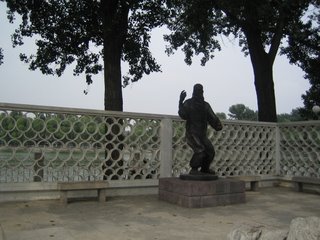Hutongs

Beijing's "hutongs" are lanes or alleys formed by lines of si he yuan (a compound with houses around a courtyard). The word "hutong" apparently originates from the Mongolian word "hottog" which means "well," referring to the fact that many hutongs were formed when villagers would dig out a well a ways off from their neigbors and would settle around the area there. Today, the word hutong refers to these ancient lanes and alleys
 where Beijing residents still live. Nearly all of Beijing's Hutongs are laid out in either east-west or north-south directions, although the clusters of buildings have developed so much over the centuries that there is not much order to be found in them today.
where Beijing residents still live. Nearly all of Beijing's Hutongs are laid out in either east-west or north-south directions, although the clusters of buildings have developed so much over the centuries that there is not much order to be found in them today.This is what my "Social Study Week" packet, distributed to us last Sunday, has to say about hutongs:
"How many hutongs are there in Beijing? Old local residents have a saying: "There are 360 large hutongs and as many small hutongs as there are hairs on an ox." Laid out in a chessboard pattern which was established as early as the Ming Dynasty, these hutongs cross-cut the city into tiny squares.
 In those days the capital was divided into the eastern, western, northern, southern and central districts, with a total of 33 neighborhoods, divided again into hutongs. In the Tang Dynasty, the city, then named Youzhou, was divided into 28 walled residential districts guarded by sentries. A curfew was enforced at night. Youzhou was renamed Xijunfu in the Liao Dynasty and the city was divided into 26 residential districts. In the Jin Dynasty it became Zhongdu (the Central Capital) and was divided again into 60 residential areas.
In those days the capital was divided into the eastern, western, northern, southern and central districts, with a total of 33 neighborhoods, divided again into hutongs. In the Tang Dynasty, the city, then named Youzhou, was divided into 28 walled residential districts guarded by sentries. A curfew was enforced at night. Youzhou was renamed Xijunfu in the Liao Dynasty and the city was divided into 26 residential districts. In the Jin Dynasty it became Zhongdu (the Central Capital) and was divided again into 60 residential areas. Under the Yuan, the city was renamed Dadu (Great Capital) and divided into 50 districts, including Jintaifang (Golden Terrace District) and Wendefang (Literature and Morality District). The 33 neighborhoods mentioned above were established under the Ming emperors Hongwu (reigned 1368-1398) and Jianwen (reigned 1399-1402). The figure increased to 40 after the time of Emperor Yongle (reigned1403-1424). The Qing rulers made use of the
 existing city structure and divided the capital into five districts, reducing the number of residential districts to 10.
existing city structure and divided the capital into five districts, reducing the number of residential districts to 10.During the last years of Dynasty, the old residential district system was abolished and Beijing divided into 10 outer districts and 12 inner districts. The city is now divided into four districts -- East City, West City, Chongwen and Xuanwu -- each of these comprised of numerous sub districts.
At present, there are about 4,550 hutongs, the broadest over four meters wide and the smallest -- the eastern part of Dongfu'an Hutong, a mere 70 cm across -- just wide enough for a single person to traverse. Although the city has changed a great deal over
 the last 500 years, the hutongs remain much the same as during Ming and Qing times."
the last 500 years, the hutongs remain much the same as during Ming and Qing times."Our trip through the hutongs of Beijing's Houhai area was simply lovely -- beautiful scenery, fascinating architecture, and, of course, wonderful company (Kevin came with us :). It was a long and somewhat tiring day (by about 4pm, the three-wheeled carriages looked mighty tempting), but definitely one of my favorite things I've done so far in Beijing. This post is short on anecdote and long on pictures and history, but that's mostly what the day involved: immersion in and experience with the living history of the capital city.


<< Home